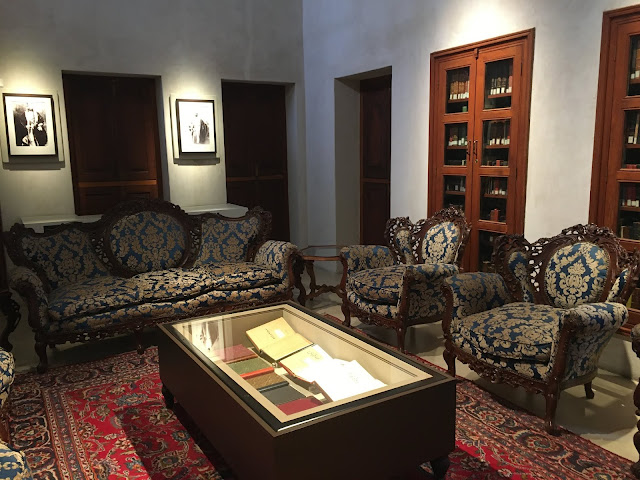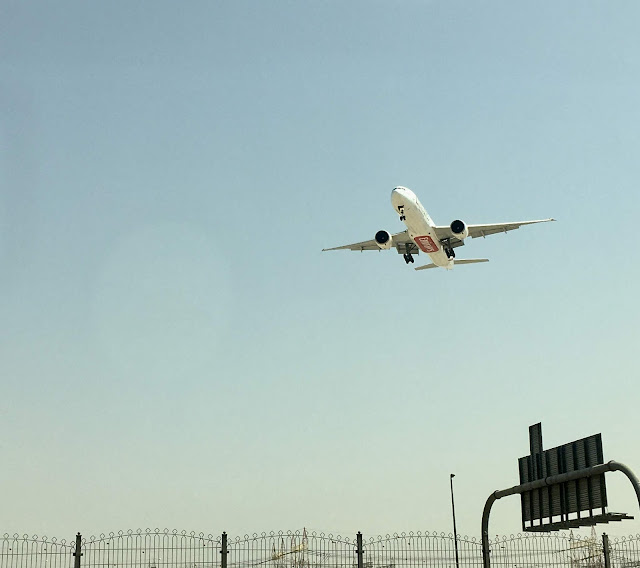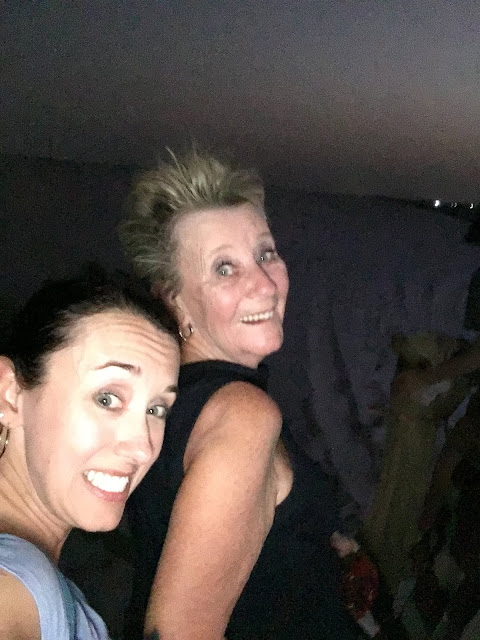I found it fascinating that the UAE was only founded so that the individual Emirates could provide protection to one another under one flag and one country. There's safety in numbers, and the seven Emirates found that out just in time to not be taken over by countries like Iran after the British pulled out of the area and removed their military protection. Bahrain and Qatar were originally posed to join the UAE but backed out at the last minute. To quote Wikipedia, "Under federal authority, responsibilities include foreign affairs, security and defense, nationality and immigration issues, education, public health, currency, postal, telephone and other communications services, air traffic control, licensing of aircraft, labor relations, banking, delimitation of territorial waters and extradition of criminals." Past this, each Emirate is on it's own and deals with its own politics.
On this particular day, we ventured out to the Sharjah Emirate. This is the MOST conservative and religious of all of the Emirates. It's the third largest and is surrounded by both the Gulf of Oman and the Persian Gulf.
Our first stop was at the Al Hisn (or Sharjah Fort.) We had a guide and I'm so embarrassed to say that I don't remember his name! I wrote all of them down except his for some reason! He was very knowledgeable and gave us a good history lesson on Sharjah. Similar to the Dubai Museum, this fort shows how life has been lived here over the past couple hundred years.
Al Ghurfah was a room that would have been used as a meeting space for local and foreign dignitaries like sheikhs, merchants and ministers. This would have been the style in the 1930s and many negotiations would have been held in a room such as this. Later, during World War II, people would listen to the BBC on the Sheikh's radio at the fort as the broadcasts would travel down the terrace to the crowds below.
Al Muhalwasa is the former jail tower that also served as a police station for a brief time. Not much remains of the original fortress which was built around 1820 and demolished around 1970. The current Sheikh of Sharjah has been instrumental in the rebuilding of many historic sights such as this one which was restored in the mid 1990s. The original doors and windows had been saved and were reused in the reconstruction. Interestingly, His Highness Sheikh Dr. Sultan bin Mohammed Al Qasimi was in university in Cairo when he heard that the Sharjah Fortress was being demolished. He rushed home to stop the demolition. Only the Al Kabs tower and a couple of semi-intact walls remained. The restoration process began in 1995 using historical documents, pictures, drawings and personal memories of what the fort looked like prior to it's destruction.
I liked their creepy mannequins - this is the Tower Guard, who would have been up here keeping an eye on the prisoners below.
As I mentioned above, the doors and windows are originals and were recovered from the demolition in the 1970s. And thank goodness for that, because look at how beautiful this is!
This is what Sharjah city used to look like! Can you believe it? How different is that! Just like the barrier islands of Indian Rocks Beach, right!?
This map shows a map of Sharjah today with how it looked over a hundred years ago. The old town area is in the orange and yellowish color. If you look at the picture above this one, you can see the barrier islands that have now become the Al Layyeh area.
One of my favorite words is juxtaposition, and I'm pretty certain I use it in at least every other one of my posts. But our guide was so funny... he said, "These buildings are very old!" My mom and I were like, "What?" Yes, he said! They were built in the 1980s! I was left scratching my head until he explained... "for a country that was only founded in 1971, these buildings are very old!" So I think the juxtaposition of these "old" buildings with the "much older" fort is really funny! Even if the fort IS a rebuild of the original.
They have a lot of old pots and furniture from the 1700s and 1800s in this museum.
This room is how the ruler of Sharjah would have lived back 200 years ago. In fact, the website says, "The bed displayed in the Sheikh’s room belongs to Sheikha Mahra Mohammed Khalifa Al Qasimi (1900-1987). It was gifted to Sharjah Fort Museum by Sheikha Meera Ahmed Rashed Al Mualla, the mother of Sheikha Jawaher who is the wife of His Highness Sheikh Dr. Sultan Bin Mohammad Al Qasimi. It is high off the floor and consists of a four steps staircase. The top of the staircase features a small closed door decorated with skillfully carved motifs and designs."
There's also a nice display of old rifles and weirdly, what a bullet hole from those rifles would look like if it entered your body!
There was also an Al Khareeja, which was a saltwater well. It wasn't used for drinking, but it could be used for doing dishes and washing clothes.
From the fort's website, it says, "The Quran stand displayed in the Qawasim Hall dates back to Sheikh Khalid bin Sultan Al Qasimi's rule (1866-1868). It is made of wood and features Arabic inscriptions carved on both sides. One side reads: "Owned by Khalid bin Sultan Bin Saqr Al Qasimi, dated 9 Muharram 1257", which is the hijri date (equivalent to 1841 AD). The other side is engraved with a verse of the Holy Quran: "Victory from Allah and a near conquest."
While the British provided protection to the Emirates prior to 1971 (and since 1820) there was also some hostility between the locals and the Brits. The Brits accused the Qawasim (the Sharjah ruling family) of being pirates so that they could "justly wage war against them." (Funny use of the word "justly.") By doing this, they could control the trade in the region. Of course, once the Brits left, the Qawasim were able to control trade in the region, but were left vulnerable to attacks by Iran and others. Hence the formation of the United Arab Emirates.
All across the UAE, there are a TON of palm trees. The coconut palm tree will not grow here (they need lots of moisture to grow.) Instead, most of the palm trees here are date palms. In the Sharjah Fortress, they had a super interesting display about the dates and the production of "Dibs." "Dibs" or date molasses was made in the Medbasa. First they would collect the ripe dates and lay them on palm leaves in the sun to dry out. Then they would be place in bags woven from palm leaves and placed across the grooves in the floor as you see above. When they pile the bags on top of each other, it squishes the dates and presses the molasses out of them. It then oozes out of the bags, into the grooves and down into ceramic pots that collect the dibs. They said it can take a month or so, but you get a lot of dibs in the first few days!
Here's another example of a "really old" 1980s building! This one is just outside of the Sharjah Fort, which we saw as we were leaving.
After our visit to the Sharjah Fort, we went over to the souk area - first to the Souk al Arsah (or Courtyard Souk.) It's one of the oldest souks in all of the UAE (some say the oldest!)
Another one of those really old buildings! Sheesh! It's practically from the middle ages!
Our last stop was the beautiful Central Souk... which is also known as the Blue Souk for it's pretty blue tiles that decorate the exterior. There are two wings - and thankfully the two wings are connected by an air conditioned, over-the-road walkway.) It was completed in 1978, but as you know, in the UAE, that is pretty old.
We walked through the air conditioned and very beautiful Blue Souk. It kind of reminded me of Grand Central Station in NYC (only that ceiling is green!)
The view from the parking lot of the Blue Souk - they even have their own Ferris Wheel (in the distance.) This is the Eye of the Emirates wheel and it provides beautiful views of the Khalid Lagoon. It was built in 2005.
There are 20 wind towers (for aesthetic purposes only) that top the Blue Souk. Inside, the two wings have 80,000 square footage of shops!

Alas it was time to head back to Dubai. The drive isn't long (about an hour and a half) but man... look at these power lines! They seem to go on for days. Interestingly, Sharjah is replacing some of their overhead lines with underground cables.
Whew! Driving back to Dubai, you go right under the landing path of the airplanes! Hello there, Emirates Airlines! Welcome (back) to Dubai!
Until next time, Sharjah!
On this particular day, we ventured out to the Sharjah Emirate. This is the MOST conservative and religious of all of the Emirates. It's the third largest and is surrounded by both the Gulf of Oman and the Persian Gulf.
Our first stop was at the Al Hisn (or Sharjah Fort.) We had a guide and I'm so embarrassed to say that I don't remember his name! I wrote all of them down except his for some reason! He was very knowledgeable and gave us a good history lesson on Sharjah. Similar to the Dubai Museum, this fort shows how life has been lived here over the past couple hundred years.
Al Ghurfah was a room that would have been used as a meeting space for local and foreign dignitaries like sheikhs, merchants and ministers. This would have been the style in the 1930s and many negotiations would have been held in a room such as this. Later, during World War II, people would listen to the BBC on the Sheikh's radio at the fort as the broadcasts would travel down the terrace to the crowds below.
Al Muhalwasa is the former jail tower that also served as a police station for a brief time. Not much remains of the original fortress which was built around 1820 and demolished around 1970. The current Sheikh of Sharjah has been instrumental in the rebuilding of many historic sights such as this one which was restored in the mid 1990s. The original doors and windows had been saved and were reused in the reconstruction. Interestingly, His Highness Sheikh Dr. Sultan bin Mohammed Al Qasimi was in university in Cairo when he heard that the Sharjah Fortress was being demolished. He rushed home to stop the demolition. Only the Al Kabs tower and a couple of semi-intact walls remained. The restoration process began in 1995 using historical documents, pictures, drawings and personal memories of what the fort looked like prior to it's destruction.
I liked their creepy mannequins - this is the Tower Guard, who would have been up here keeping an eye on the prisoners below.
As I mentioned above, the doors and windows are originals and were recovered from the demolition in the 1970s. And thank goodness for that, because look at how beautiful this is!
This is what Sharjah city used to look like! Can you believe it? How different is that! Just like the barrier islands of Indian Rocks Beach, right!?
This map shows a map of Sharjah today with how it looked over a hundred years ago. The old town area is in the orange and yellowish color. If you look at the picture above this one, you can see the barrier islands that have now become the Al Layyeh area.
One of my favorite words is juxtaposition, and I'm pretty certain I use it in at least every other one of my posts. But our guide was so funny... he said, "These buildings are very old!" My mom and I were like, "What?" Yes, he said! They were built in the 1980s! I was left scratching my head until he explained... "for a country that was only founded in 1971, these buildings are very old!" So I think the juxtaposition of these "old" buildings with the "much older" fort is really funny! Even if the fort IS a rebuild of the original.
They have a lot of old pots and furniture from the 1700s and 1800s in this museum.
This room is how the ruler of Sharjah would have lived back 200 years ago. In fact, the website says, "The bed displayed in the Sheikh’s room belongs to Sheikha Mahra Mohammed Khalifa Al Qasimi (1900-1987). It was gifted to Sharjah Fort Museum by Sheikha Meera Ahmed Rashed Al Mualla, the mother of Sheikha Jawaher who is the wife of His Highness Sheikh Dr. Sultan Bin Mohammad Al Qasimi. It is high off the floor and consists of a four steps staircase. The top of the staircase features a small closed door decorated with skillfully carved motifs and designs."
There's also a nice display of old rifles and weirdly, what a bullet hole from those rifles would look like if it entered your body!
There was also an Al Khareeja, which was a saltwater well. It wasn't used for drinking, but it could be used for doing dishes and washing clothes.
From the fort's website, it says, "The Quran stand displayed in the Qawasim Hall dates back to Sheikh Khalid bin Sultan Al Qasimi's rule (1866-1868). It is made of wood and features Arabic inscriptions carved on both sides. One side reads: "Owned by Khalid bin Sultan Bin Saqr Al Qasimi, dated 9 Muharram 1257", which is the hijri date (equivalent to 1841 AD). The other side is engraved with a verse of the Holy Quran: "Victory from Allah and a near conquest."
While the British provided protection to the Emirates prior to 1971 (and since 1820) there was also some hostility between the locals and the Brits. The Brits accused the Qawasim (the Sharjah ruling family) of being pirates so that they could "justly wage war against them." (Funny use of the word "justly.") By doing this, they could control the trade in the region. Of course, once the Brits left, the Qawasim were able to control trade in the region, but were left vulnerable to attacks by Iran and others. Hence the formation of the United Arab Emirates.
All across the UAE, there are a TON of palm trees. The coconut palm tree will not grow here (they need lots of moisture to grow.) Instead, most of the palm trees here are date palms. In the Sharjah Fortress, they had a super interesting display about the dates and the production of "Dibs." "Dibs" or date molasses was made in the Medbasa. First they would collect the ripe dates and lay them on palm leaves in the sun to dry out. Then they would be place in bags woven from palm leaves and placed across the grooves in the floor as you see above. When they pile the bags on top of each other, it squishes the dates and presses the molasses out of them. It then oozes out of the bags, into the grooves and down into ceramic pots that collect the dibs. They said it can take a month or so, but you get a lot of dibs in the first few days!
Here's another example of a "really old" 1980s building! This one is just outside of the Sharjah Fort, which we saw as we were leaving.
After our visit to the Sharjah Fort, we went over to the souk area - first to the Souk al Arsah (or Courtyard Souk.) It's one of the oldest souks in all of the UAE (some say the oldest!)
Another one of those really old buildings! Sheesh! It's practically from the middle ages!
Our last stop was the beautiful Central Souk... which is also known as the Blue Souk for it's pretty blue tiles that decorate the exterior. There are two wings - and thankfully the two wings are connected by an air conditioned, over-the-road walkway.) It was completed in 1978, but as you know, in the UAE, that is pretty old.
We walked through the air conditioned and very beautiful Blue Souk. It kind of reminded me of Grand Central Station in NYC (only that ceiling is green!)
The view from the parking lot of the Blue Souk - they even have their own Ferris Wheel (in the distance.) This is the Eye of the Emirates wheel and it provides beautiful views of the Khalid Lagoon. It was built in 2005.
There are 20 wind towers (for aesthetic purposes only) that top the Blue Souk. Inside, the two wings have 80,000 square footage of shops!

The manhole covers of Sharjah feature a sparkly diamond! You know my love of sparkly things runs deep!
As we were leaving the Blue Souk, I thought that the front kind of looked like the front of an oncoming train.
Alas it was time to head back to Dubai. The drive isn't long (about an hour and a half) but man... look at these power lines! They seem to go on for days. Interestingly, Sharjah is replacing some of their overhead lines with underground cables.
Whew! Driving back to Dubai, you go right under the landing path of the airplanes! Hello there, Emirates Airlines! Welcome (back) to Dubai!
Until next time, Sharjah!








































































